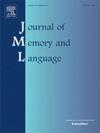Orthographic-Semantic consistency effects in lexical decision: What types of neighbors are responsible for the Effects?
IF 3
1区 心理学
Q1 LINGUISTICS
引用次数: 0
Abstract
Recent research (e.g., Marelli & Amenta, 2018; Siegelman, Rueckl, Lo, Kearns, Morris & Compton, 2022) has demonstrated a significant orthographic-semantic (O-S) consistency effect on lexical decision performance. Specifically, lexical decision latencies were faster for words with a consistent O-S relationship than for words that do not have a consistent O-S relationship, with consistency being defined in terms of the semantics of those words’ “orthographic neighbors”. Interestingly, however, the words assumed to be orthographic neighbors were different across the studies and, therefore, different factors may have been at work in the two situations. In order to more closely examine the origin of O-S consistency effects in lexical decision tasks, we first attempted to replicate both of those results. Then, we examined O-S consistency effects based on addition (e.g., cats-CAT, pant-PAN), substitution (e.g., cot-CAT, pin-PAN) and deletion (seat-SAT, road-ROD) neighbors separately for mono-morphemic English words in both the datasets used in the previous studies and, based on the former two neighbor types, in a lexical decision experiment. Throughout our data analyses, we observed that addition neighbors play an important role in producing an O-S consistency effect in lexical decision performance. In contrast, we failed to observe a significant O-S consistency effect when consistencies were computed based only on the substitution (or deletion) neighbors. Because addition neighbors involve many morphologically-related neighbors, we further examined the roles that morphologically-related and unrelated neighbors play in producing the O-S consistency effect. Those analyses revealed that the O-S consistency effect for addition neighbors is largely produced by the combination of a processing advantage when a word has many morphologically-related neighbors and a processing disadvantage when a word has many morphologically-unrelated neighbors. More broadly, this research demonstrates that readers pick up on the statistical relationships between spelling and meaning.
词汇决策中的正字法-语义一致性效应:哪些类型的邻域对这种效应负责?
最近的研究(例如,马瑞利;Amenta, 2018;西格尔曼,鲁克尔,罗,卡恩斯,莫里斯&;康普顿(Compton, 2022)证明了正字法-语义一致性对词汇决策绩效的显著影响。具体来说,具有一致的O-S关系的单词比不具有一致的O-S关系的单词的词汇决策延迟更快,一致性是根据这些单词的“正字法邻居”的语义来定义的。然而,有趣的是,被认为是正字法邻居的单词在研究中是不同的,因此,不同的因素可能在两种情况下起作用。为了更仔细地研究词法决策任务中O-S一致性效应的起源,我们首先尝试复制这两个结果。然后,我们在之前的研究中使用的两个数据集中分别检测了基于添加(例如,cats-CAT, pant-PAN),替换(例如,cot-CAT, pin-PAN)和删除(seat-SAT, road-ROD)邻居的单语素英语单词的O-S一致性效应,并基于前两种邻居类型,在词汇决策实验中进行了测试。在整个数据分析过程中,我们观察到加法邻居在词法决策性能中产生O-S一致性效应方面发挥了重要作用。相比之下,当仅基于替换(或删除)邻居计算一致性时,我们未能观察到显著的O-S一致性效应。由于添加邻域涉及许多形态相关邻域,我们进一步研究了形态相关邻域和不相关邻域在产生O-S一致性效应中的作用。这些分析表明,添加邻词的O-S一致性效应主要是由两个因素共同作用产生的:当一个词有许多词形相关的邻词时,它具有加工优势;当一个词有许多词形无关的邻词时,它具有加工劣势。更广泛地说,这项研究表明,读者会注意到拼写和意思之间的统计关系。
本文章由计算机程序翻译,如有差异,请以英文原文为准。
求助全文
约1分钟内获得全文
求助全文
来源期刊
CiteScore
8.70
自引率
14.00%
发文量
49
审稿时长
12.7 weeks
期刊介绍:
Articles in the Journal of Memory and Language contribute to the formulation of scientific issues and theories in the areas of memory, language comprehension and production, and cognitive processes. Special emphasis is given to research articles that provide new theoretical insights based on a carefully laid empirical foundation. The journal generally favors articles that provide multiple experiments. In addition, significant theoretical papers without new experimental findings may be published.
The Journal of Memory and Language is a valuable tool for cognitive scientists, including psychologists, linguists, and others interested in memory and learning, language, reading, and speech.
Research Areas include:
• Topics that illuminate aspects of memory or language processing
• Linguistics
• Neuropsychology.

 求助内容:
求助内容: 应助结果提醒方式:
应助结果提醒方式:


